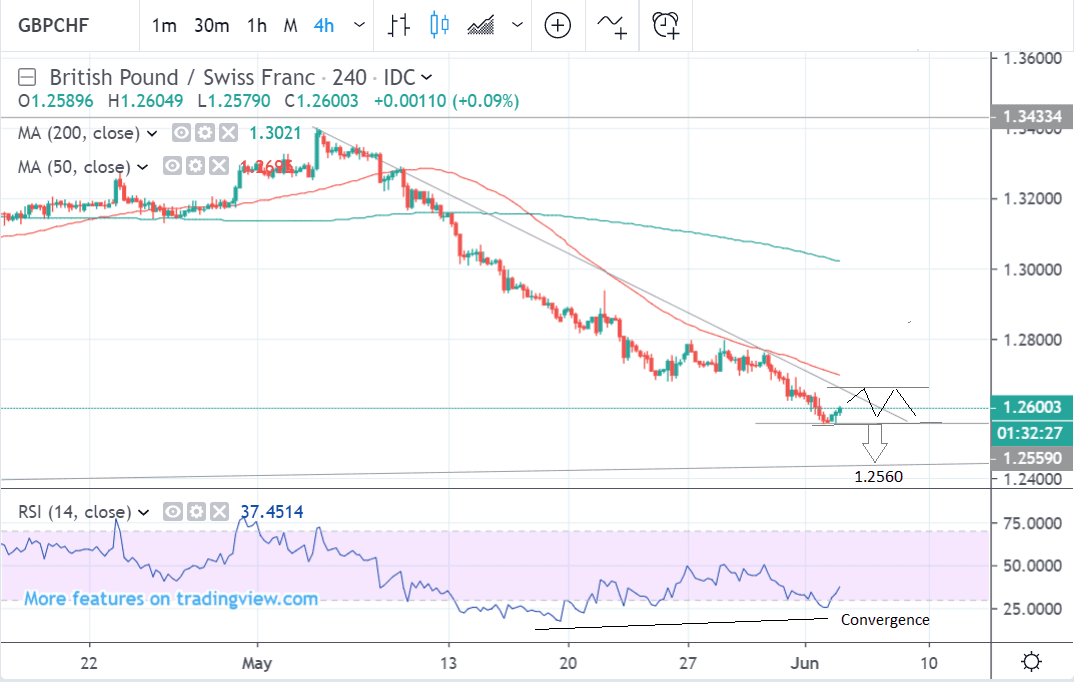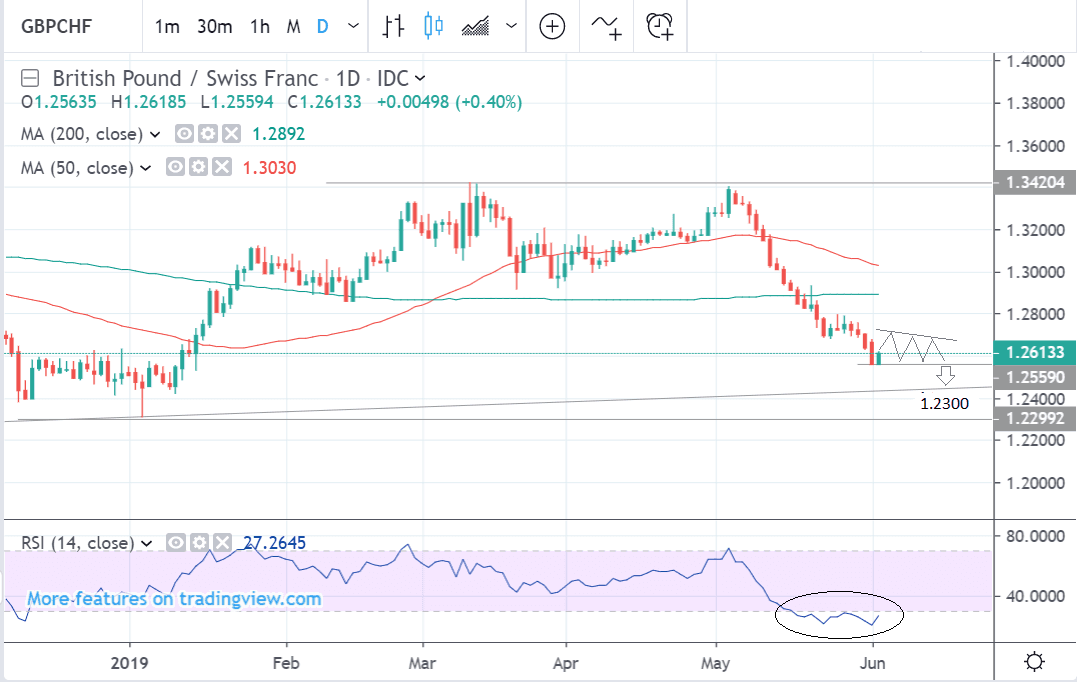Pound-Franc Outlook is Now Negative-to-Neutral

Image © Adobe Images
- GBP/CHF in downtrend but registering oversold
- Suggests sideways trend could form
- Further downside conditional on new lows
The Pound-to-Franc exchange rate is trading at around 1.2600 at the time of writing, a quarter of a percent lower on the week, with studies suggesting either the possibility of more downside or of a heightened chance of a sideways trend forming in the days ahead.
The 4 hour chart below shows the pair in a steep downtrend ever since the start of May. Given the old adage that “the trend is your friend” this confirmed downtrend would normally be expected to continue.
The oversold and converging RSI momentum indicator in the bottom panel, however, suggests moderating this bearish stance. It is a sign the downtrend could stall or possibly reverse.
Although the fact the pair is in a downtrend trumps all other considerations and we are, therefore, bearish overall, we are only bearish on the condition that the pair can break to new lows.
A move below the 1.2560 June 3 lows, would probably curry conviction for a move down to a target at support at 1.2300, otherwise, a neutral sideways trend is forecast.
The above forecast is for the remainder of the week and the start of next week as the 4-hour chart gives us an indication of the short-term outlook spanning around 5 trading days.
Taking a step back to get an overview of the broader picture, we see the daily chart tells the same story - the pair is in an established downtrend which is likely to continue lower but the RSI momentum indicator in the bottom panel is turning higher, suggesting bullish tendencies.
The RSI has arguably formed a double bottom reversal pattern in the oversold zone, which is a bullish sign for both the RSI and the underlying asset price. The exit out of the oversold zone is a signal to open new bullish bets.
These contradict the overall bearish trend. The resolution of the paradox might be in the trend going sideways in a range between 1.25-27 over the next 1-4 weeks.
As in the short-term forecast above, we are bearish, but only on the condition the pair can break below the 1.2560 June 3 lows. Such a break would probably then lead to a move down to a target at 1.2300 January lows.
We use the daily chart to give us an indication of the medium-term outlook which includes the next couple of weeks to a month.
The weekly chart shows a more clearly bearish outlook in the long-term. We note the 3 black crows Japanese candlestick pattern which formed after the early May highs (circled) which consists of three long, red, down bars in a row. This is a bearish long-term signal.
It suggests the pair probably has lower to go and will eventually reach the 1.2300 lows and the 1.2000 level after that, in the next 1-3 month time period.
We use the weekly chart to give us an idea of the longer-term outlook, which includes the next few months.
Time to move your money? Get 3-5% more currency than your bank would offer by using the services of foreign exchange specialists at RationalFX. A specialist broker can deliver you an exchange rate closer to the real market rate, thereby saving you substantial quantities of currency. Find out more here. * Advertisement
The Swiss Franc Tipped to Continue Outperforming in Current Risk-Off Markets
The main driver of the Swiss Franc is global investor risk appetite which is deteriorating on concerns about the economic impact of an escalation in the trade war.
The Franc is a safe-haven currency which means it benefits from inflows during times of turbulence - much like gold.
The Franc has been doing relatively well, therefore, following the recent escalation in the conflict between the U.S. and its trading neighbours. This probably explains the relatively steep downtrend in GBP/CHF during May.
The U.S.-lead trade war between expanded last week when the U.S. put Mexico in its sights, looking to use trade as leverage over its southern neighbour to stem illegal immigration. The U.S. Dollar has fallen during the course of this time, suggesting the world's number 1 currency is not considered a 'safe haven' in this environment.
"The most likely argument is that the movements seen since the middle of last week have been related to deteriorating risk sentiment," says Simon Derrick, Chief Currency Strategist with BNY Mellon. "This is certainly consistent with the increased bid for not just the JPY, but also the CHF and gold since Wednesday, along with the USD’s rather more uninspiring performance over the same period.
The U.S.-China trade stand-off meanwhile rumbles on, ensuring the risk-averse atmosphere that favours the Franc could be with us for some time yet.
Recently the U.S. blacklisted Huawei due to national security concerns and last weekend China retaliated by starting an investigation into U.S. logistics giant FedEx with the possibility they will bar Fedex from operating in China.
The Chinese have also said they may cut off exports of rare earth metals to the U.S. which are used in a host of high-tech and military applications including cell-phones, televisions, audio systems, solar panels, satellites, and lasers.
China supplies over 80% of rare earth metals imported by the U.S. so such a trade ban could really hit the U.S’s ability to produce many widely used tech components, at least in the short-term.
But one reason why the Chinese may relent is that such a ban would increase the price of rare earth metals and thereby loosen China’s stranglehold on the market.
Up until now, China has been able to manipulate the market because of its vast stockpiles of rare earth metals, pricing out competitors before they can get a foothold by swamping the market when it wants lower prices.
If the price were to spike on a U.S. ban, it would make feasible the opening of new mines in other parts of the world known to be rich in rare earth metals such as Australia and Africa, and this would provide competition for China.
The U.S. stock market’s steep decline in May is a reflection of the low market appetite for risk and a more negative view of the U.S. economy.
The fall in U.S. Treasury bond yields is a sign investors are taking flight into ‘’safer’ bonds and leaving equities. This could be a sign they fear a recession coming.
On the domestic front, data out on Monday showed inflation rate holding at 0.3% in May and Swiss Business activity survey SVME declining further to 48.6 when 49.1 had been forecast. Readings below 50 are a sign of contraction.
The unemployment rate is out on Friday at 6.45 BST and the non-seasonally adjusted rate is forecast to drop to 2.3% from 2.4% previously, whilst the seasonally adjusted rate is expected to remain at 2.4%.
Time to move your money? Get 3-5% more currency than your bank would offer by using the services of foreign exchange specialists at RationalFX. A specialist broker can deliver you an exchange rate closer to the real market rate, thereby saving you substantial quantities of currency. Find out more here. * Advertisement


